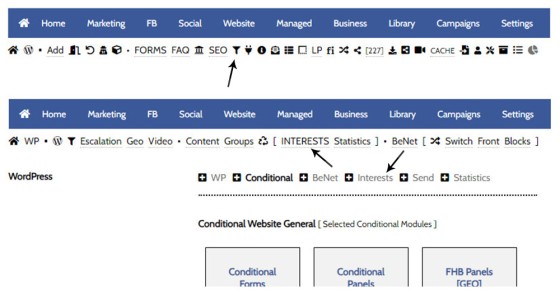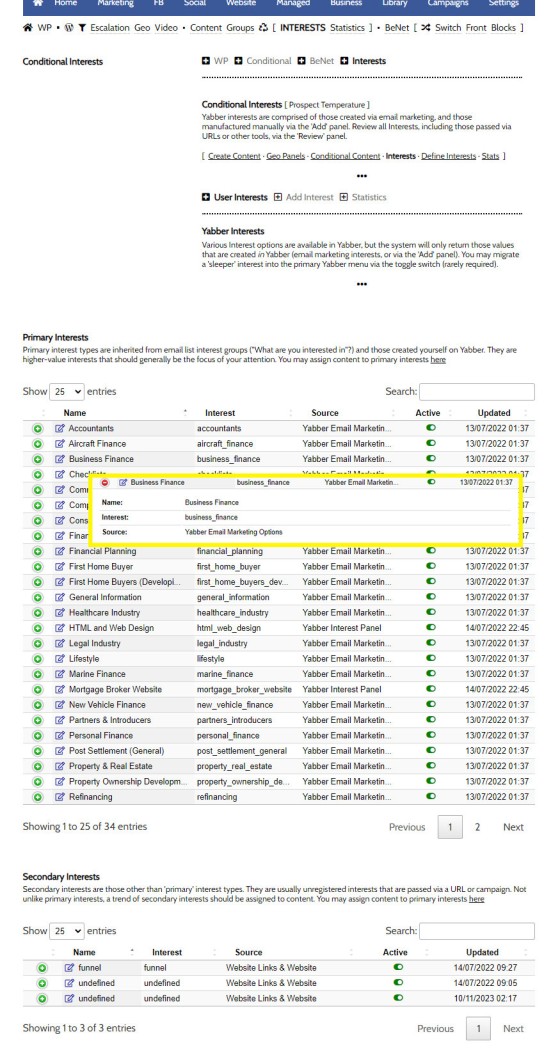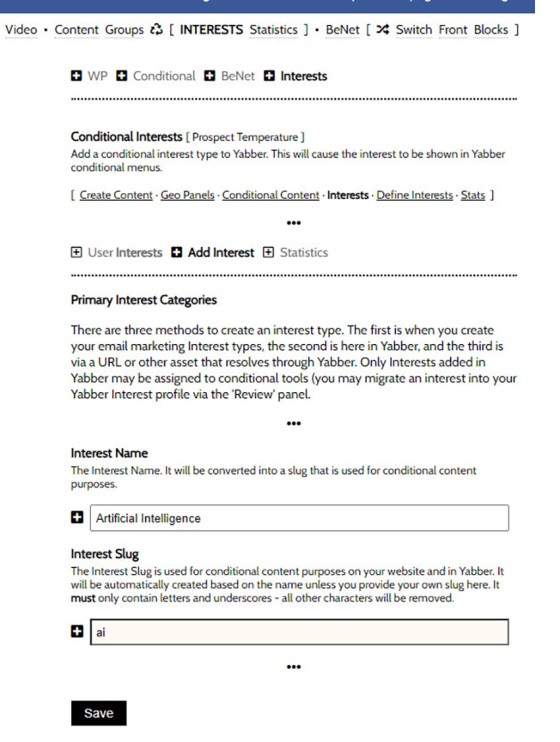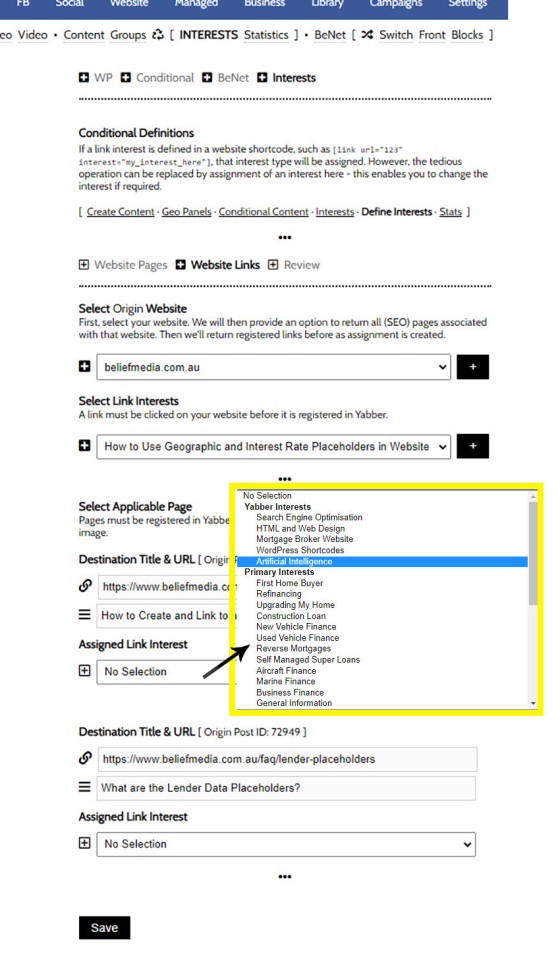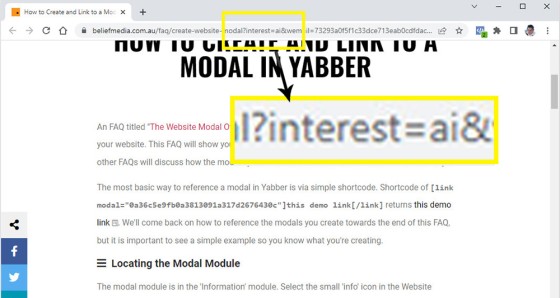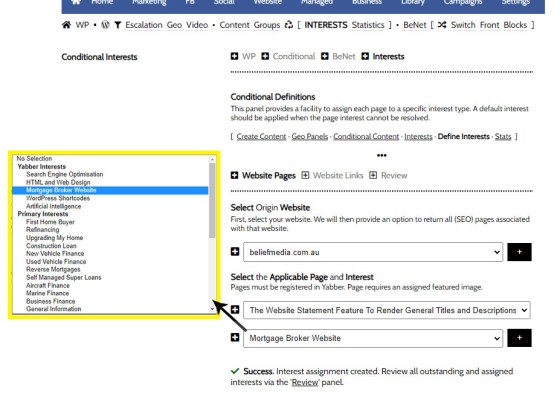Conditional Content is content that is delivered to a user based on resolved borrowing objective, occupation, campaign links, or interest. In the property field the Interest might be a particular type of property or a category of buyer. Supported by BeNet, the use of Conditional Content must be considered an advanced feature, although those elements on your front page, escalating forms, and some other conditional features, are extremely easy to implement and use.
A funnel is predicated on relevance, and relevance is the kindle that'll amplify the impact of your funnel and keep your funnel participant engaged, Conditional Content is focused on serving content to a user that we know that they're interested in seeing. Relevance will deliver more engagement and page views which will invariably return more conversions.
Any link, modal, page view, tooltip, video view, form interaction, or any other type of interaction, will always be interest based. In other words, what is the user telling me by clicking on this link or modal? As you've seen with virtually all the modules we introduce in these FAQs, each and every interaction-based asset will always include an interest type, and this interest is a declared interest rather than the 'resolved' interest the AI will guess based on activity and context. Bottom line: everything a user does is giving us a piece of a puzzle, and when you put these pieces together it starts to form a very clear story. This story resolves to a clear objective, occupation, or some other 'category' of user that will potentially allow us to deliver very relevant and targeted content to that specific user. It's for this reason that we call our framework a 'Chameleon' because it literally changes shape to maintain consumer relevance, and this relevance is applied differently to each and every user. Developed by us to mitigate the utterly ridiculous nature of 'static' websites, the system would cost thousands of dollars in the open market, but for us, it's just 'another feature'... and it's one we don't factor into the cost because so few businesses will ever use it.
A general familiarity with our overarching Conditional Ideology and Funnel methodology is assumed for this FAQ. However, while it's an advanced concept, it's not a difficult concept... but it can become something that demand ask more of your time.
A Note on Email Marketing: It's worth noting that all the links in follow-up emails will must carry a link to your website to introduce a resource of some type, and these links will themselves carry indicators of funnel interest or objective. The email will also carry the campaign ID which can also force content. This is one of the seriously significant advantages of using an integrated email marketing system - it is more effective from a marketing perspective than competing solutions.
A Note on Triggers: Any and all interactions are tracked to the user level. This enables us to apply triggers in ways that deliver a significant advantage to your operation over competing solutions. A trigger is a 'type' of conditional marketing in that we conditionally alter the funnel based on various types of interactions, but it's more than that. The initial interaction gives us a paragraph of a story, and with enough interactions we start to compile a story... while a trigger makes a single assumption based on a single interaction... so the conditional aspects are far more accurate.
Conditional Overview: Read the article in our blog titled "An Overview of the Mortgage Broker Website Conditional Features". It should always be considered out-of-date. Another article introduces the Interest Types in more detail, and another introduces funnel relevance. Our blog contains a large number of articles that discuss Conditional advantages in your marketing efforts.
Again, while it's challenging to avoid talking about the psychology and science of conditional marketing, the FAQ requires brevity. Ensure you read our website and review tutorials on various conditional concepts.
Use of the Conditional features are entirely optional and not required. There's an expectation that larger businesses will take advantage of the functionality.
What Will We Introduce in This FAQ?
In this FAQ we will introduce the concept of an interest, and we'll look at how to define interests for page views and links. We'll also briefly review the interest as it is applied to other modules.
The BMUID
The BMUID is a unique user identifier that tracks all user interactions. The ID is assigned to all users, and then if and when they convert in some way, we can reactively assign all interactions to the ID based on our new understanding. This BMUID also applies to Telco (VOIP) modules, and it aggregates all the emails, phone numbers, and other information, that is ever supplied by a suer. We generally identify a user by way of an email marketing link click or form interaction of any type.
Resolving a user to a BMUID is important for conditional purposes, but it is also important so we're able to effectively manufacture a user heat index, or a temperature that's assigned to each user. Based on the historical conversion information, BeNet is able to identify conversion pathways, identify blocks of content that convert better than others, and make suggestions for funnel improvements.
What is an Interest?
An 'interest' should be considered a category of any type. Any interest is a siloed group of individuals of any type. For example, an interest may be a borrowing objective (refinance, first home buyer), an occupation (medic, legal, emergency personnel, military, property client etc.) or anything else that you feel will group users for the purpose of crafting out relevance-based funnels. If you wanted it, an interest could be dog lovers, people with blue eyes, or anything else. In reality, you'll keep your interest types to a minimal to ensure that we create large groups of users in a smaller number of essential interest types.
Some interest are created by default by Yabber, while other interests are inherited by the email marketing system, but you're able to create as many interest types that float your boat. Any interest created in Yabber will be a 'Yabber Interest', while those created by Yabber on your behalf are called 'Primary Interests'. There are also 'Secondary Interests', and we'll talk about these shortly.
Let's go ahead and create an interest for the purpose of demonstrating how the system will function.
Locating the Interest Panels
Interest are defined in the Conditional Module. From the Website module, select the 'Funnel' icon. This returns a large number of Conditional options. Select the 'Interests' options from within the returned submenu.
Pictured: Interest are defined in the Conditional Module. From the Website module, select the 'Funnel' icon. This returns a large number of Conditional options. Select the 'Interests' options from within the returned submenu.
Select the 'Interest' option to return the primary Interest panel.
Creating and Managing Interests
All Interests registered to Yabber are shown in the Interests panel. The same panel provides a facility to add an Interest.
Pictured: All Interests registered to Yabber are shown in the Interests panel. The same panel provides a facility to add an Interest. The accordion panel for each Interest returns the title and slug.
We'll go ahead and create a brand new Yabber interest call 'Artificial Intelligence', and we'll assign the slug of 'ai'. A slug can usually be ignored, but it becomes relevant if we're ever going to hardcode an interest to a website asset (we'll show you how to do this shortly). Slugs may only contain letters and underscores, and they should be short, descriptive, and easy to remember. Once created, you will find the Interest registered in the Interests panel.
Pictured: We'll go ahead and create a brand new Yabber interest call 'Artificial Intelligence', and we'll assign the slug of 'ai'. A slug can usually be ignored, but it becomes relevant if we're ever going to hardcode an interest to a website asset (we'll show you how to do this shortly). Slugs may only contain letters and underscores, and they should be short, descriptive, and easy to remember.
Once this Interest is added you'll find it in the Interests panel  .
.
Assigning Interests to Link Shortcode
Links are an effective 'declared' manner in which to resolve the objective of a story. A funnel of any type is a conversation, and a user interaction is the user 'talking back to us'. The link is the equivalent of a user answering a question we never got to ask.
The primary method of assigning a page link is in Yabber, but we may also hardcode the interest directly into the link itself. In a previous FAQ we introduced the method of creating a trackable internal or external link [link url="13609"]as follows[/link]. We may assign an Interest directly to this link by adding the interest attribute, so the link will now [link url="13609" interest="ai"]look like this[/link].
We're using the newly created 'ai' Interest, but we can create a brand new Interest via this method but it'll be a Secondary Interest that carries less authority (because it's a fixed and unregistered resource).
Anything fixed in nature should be avoided, and hardcoding an interest into a link is like settling for a static billboard over a remotely-monitored billboard.
Assigning Interests to a Link in Yabber
A short time after any article or page on your website is published, it is ingested into Yabber for SEO and other purposes. All links are evaluated and recorded in the Conditional system. We may then assign each link on the page an Interest. This is the preferred manner to assign an Interest as it may be easily altered if required. Select the 'Define Interests' panel to return link and page assignment options.
We'll start by assigning the brand new interest of 'ai' to a link (and page) to an FAQ article. For the sake of it, we'll use the article detailing Geographic Rate Placeholders in Modals (this link is important - we'll come back to it in a moment). Two page links are returned for this page - we'll assign the 'ai' interest to both of them.
Pictured: A short time after any article or page on your website is published, it is ingested into Yabber for SEO and other purposes. All links are evaluated and recorded in the Conditional system. We may then assign each link on the page an Interest. This is the preferred manner to assign an Interest as it may be easily altered if required. Select the 'Define Interests' panel to return link and page assignment options.
This interest is now assigned to this link. Whenever a user clicks the link that details how to use Geographic Placeholders in Modals, the request is passed through Yabber for multiple reasons, and the returned URL carries the interest type in the URL. First of all, if a nonsense interest, it is rejected. Second, if the interest isn't registered it is also rejected.
Pictured: The link request is passed through Yabber for multiple reasons, one of which is to resolve the link interest, and the returned URL carries the interest type in the URL.
Yabber will register this interest and perform a large number of functions (we'll come back to these important Yabber-based actions shortly), and your website will record an incremental count of the interest - a very simple method. For all intents and purposes, the interest in the link carries a 'weight' of one unit, although Yabber may make a deamination and alter the interest significance by increasing the 'weight' value. This BeNet-based latter method can generally be ignored for the moment.
When the interest is registered on your website it is recorded in a user session and cookie.
I'm going to go ahead and click on this link a few times  in order to give the 'ai' interest a larger count. The result of your clicks is 0. If you haven't clicked that link yet, do so in a new window and then come back and review the increased count.
in order to give the 'ai' interest a larger count. The result of your clicks is 0. If you haven't clicked that link yet, do so in a new window and then come back and review the increased count.
Interest Type Shortcode: The count returned above is by way of shortcode that looked as follows: [bm_interest_key interest="ai"]. If the interest field is defined as empty an array of all interests is returned. The function is purely for testing purposes. Most of your actions won't be recorded by the conditional system, so the number of 'undefined' pages for you is 1. The undefined values are not defined on your website but they are resolved by way of AI in Yabber.
The reality is that we'll have multiple counts of multiple interests, and the incremental increase in count is not always 1. While the mechanics on your website is relatively simple, the backend mashup of data in Yabber is very sophisticated.
Not all links will have an interest assigned. Try and assign an interest only when you would like Yabber to recognise the link as a clear user declaration. Make attempts to recognise the noise from a signal in links and pages.
Forcing Conditional Content
We may have certain links that are clear indicators of objective. These links might be along the lines of "What are you interest in?" with a few available options. On the basis of very clearly defined and objective based link, we can force conditional content to be shown. Available only in website links shortcode, we can construct a link as follows: [link url="70901" interest="ai" rs="20"], and will be returned as follows. The link will redirect back to this page, and the rs attribute will force a greater interest score of 20. Click on the link and review the ai interest score (currently 0).
In those cases where we've forced an RS (known as a 'Redirect Score', which assigns the Interest weight), Conditional content is more likely to show for those users since a significant margin was applied to the Interest. If you absolutely wanted to force an Interest, use a much higher score, such as 1000.
The score returned to your page may not be precisely as defined. In some cases, BeNet will alter the score based on its 'better' understanding of user objectives.
Important: If no interest is explicitly defined, the 'undefined' (default) interest will increment at a rate of 0.05 per page view. This means that 20 unassigned page views or clicks will have the same weight as a single assigned page or click.
The Switch Module: The module that'll switch your website from one to another can be resolved based on the progressive interest score but may also be forced in a manner we've just described.
Assigning Interests to a Pages in Yabber
Every page on your website should have a clear objective. Some pages are easier to resolve than others, such as pages on Refinancing or First Home Buyers. Those pages will an identifiable objective should be registered in Yabber to give BeNet a better understanding of the purpose of the page.
Pictured: Every page on your website should have a clear objective. Some pages are easier to resolve than others, such as pages on Refinancing or First Home Buyers. Those pages will an identifiable objective should be registered in Yabber to give BeNet a better understanding of the purpose of the page.
Whenever the page is viewed an incremental interest assignment is made in Yabber.
Interests Defined in Other Assets
Interest are defined everywhere. Each modal, for example, should have a clear objective, so the modal form provides an option to assign an interest at the bottom of the form  . We've singled out modals, but the Interest option is everywhere, so as you create any asset be mindful that any assigned interest will have an impact on BeNet's ability to resolved the purpose of your user.
. We've singled out modals, but the Interest option is everywhere, so as you create any asset be mindful that any assigned interest will have an impact on BeNet's ability to resolved the purpose of your user.
User Defined Values are Just the Beginning
In another FAQ we introduce how to enable and disable BeNet. In short, BeNet makes determinations on Interest and returns the user interest or the resolved interest back to your website, and it will usually assign a weight score to the interest (so, an interest of first_home_buyers might carry a value of 30 giving it a clear lead over any user defined values). In some cases, BeNet may send an instruction back to your website to switch the front page out for another entirely.
In terms of delivering Conditional Content, the primary method for users to achieve this is accomplished via various content Blocks. The FAQ titled "Creating Conditional Website Blocks and Returning Content with Elementor or Shortcode" should be referenced for an understanding of how the system works, although conditional content plays a part everywhere, such as in modals, videos, the front page, and elsewhere.
Conditional Content is a big topic.
The User Temperature
Outside the scope of this FAQ, a heat index (or 'Temperature') is assigned to each user in all of your funnels. It's not just the simple interest that applies in this instances, but big-picture and holistic interaction evaluations of any type and from any source, such as Email Marketing, SMS Marketing, as Telco calls. On the basis of this understanding we're able to reliably predict the success of all our digital campaigns. Conditional and BeNet resolution is far more than just simple interest types.
■ ■ ■
Conditional Content FAQs
The Conditional content module is significant. The FAQs listed below may exclude some of the basic conditional features, such as some of the Front Page conditional blocks.
Your website includes a very large number of methods to include different types of headings, including Titles and Statements (both of which serve a specific purpose), with other shortcode and Elementor tools making the addition of various 'headings' a piece of cake. While there are any number of ways to generate page titles,… [ Learn More ]
The First Email is an action that will conditionally send the first email to a user after a subscription of any type based on their form interaction. The First Email sent to a user will be determined based on the nature of their subscription - are they a subscriber, phone contact, or calendar booking? A… [ Learn More ]
The Conditional Content Blocks arguably the more effective method of rendering blocks of conditional content. The 'Blocks' module introduced similar functionality to what we're about to described, but if you're starting with Conditional Content, we'd suggest you use this module rather than Blocks simply because of the ease a single page may be assigned… [ Learn More ]
Conditional Content is one of the defining features of your website framework. Despite the fact the Conditional Content blocks are often avoided because of the perceived complexity, they seriously amplify the effectiveness of any organic or promoted funnel. We appreciate that many brokers just 'want a website', and that's find, but if and when the… [ Learn More ]
We generally advocate for brokers to position themselves in various ways by way of standalone websites that have a defined siloed audience and serve a very specific purpose. However, managing multiple websites can be problematic for a number of reasons, with duplicate content and time requirements probably topping the list. If managed correctly - and… [ Learn More ]
You want those marketing assets on the periphery to property represent your brand, but you also want them to be consistent with your trending website traffic or consumer sentiment. For example, with the introduction of a FHB or Investor incentive of some kind you will likely want your broader marketing footprint to reflect this, or… [ Learn More ]
You want those marketing assets on the periphery to property represent your brand, but you also want them to be consistent with your trending website traffic or consumer sentiment. For example, with the introduction of a FHB or Investor incentive of some kind you will likely want your broader marketing footprint to reflect this, or… [ Learn More ]
It's typical to change your social media banners of all types based on seasons, such as Christmas, Anzac Day, Easter or similar. A module in Yabber permits you to define start and stop dates for a specific banner, and that banner will automatically be applied (and later replaced with your 'default' banner). This FAQ shows… [ Learn More ]
Conditional Content is content that is delivered to a user based on resolved borrowing objective, occupation, campaign links, or interest. In the property field the Interest might be a particular type of property or a category of buyer. Supported by BeNet, the use of Conditional Content must be considered an advanced feature, although those… [ Learn More ]
Almost without question, BeNet is the single most sophisticated AI made available in the finance industry. For all intents and purposes, it has to be considered to be an extremely knowledgeable mortgage broker with an expert understanding of digital marketing, processes, systems, policies, property, finance, best practice, and your marketing efforts. BeNet is connected to… [ Learn More ]
In a previous FAQ we look at how to create and manage "Entry and Exit Intent Modals" for Your Entire Website or a Single Page. The system defined modals that will shown on your website after a defined number of seconds, or when the user indicates intent to leave the page. In this FAQ… [ Learn More ]
This FAQ will details how to use the standard Entry and Exit modals on your website. The Modal module is quite large and includes a number of options designed specifically for the finance industry, so what we're dealing with here is how to create and maintain the 'standard' entry and exit modal as it applies… [ Learn More ]
Resulting from various State-level Government incentives and fees, one of the areas that differs significantly from state-to-state is the purchase of a first home. The FHB Panel is one of the simplest conditional features of any type to use because it serves content that is resolved by State - not interest, which is the typical… [ Learn More ]
Conditional Content is content that is delivered to a user based on resolved borrowing objective, occupation, campaign links, or interest. Your website is a shape-shifting chameleon in that it delivers different content to different users in order to maintain higher levels of engagement and ultimately convert more clients. Conditional features are designed to amplify the… [ Learn More ]
Forma And Panel escalation is a component of the large Conditional Content framework that underpins your mortgage broker website and finance funnels. Basic conditional content features are introduced in an FAQ titled The Basics of Conditional Content and Interest Types, while advanced methods are addressed individually. One of the simplest conditional options to employ… [ Learn More ]


